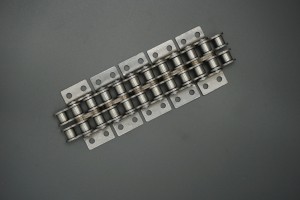If you work with machinery or simply want to understand the mechanics of various equipment, you may have come across the term “roller chain.” Roller chains are an important component of many types of machinery, including bicycles, motorcycles, industrial equipment, and more. Identifying a roller chain can be a valuable skill, especially if you need to maintain or replace it. In this guide, we’ll explore the key characteristics of roller chains and give you the knowledge to identify them with confidence.
Understand the basics of roller chains
Before we dive into the identification process, let’s first understand what a roller chain is. A roller chain is a chain drive commonly used to transmit power in a variety of mechanical systems. It consists of a series of interconnected chain links, each with a cylindrical roller located between an inner and outer plate. These rollers allow the chain to smoothly engage the sprockets to transfer power from one shaft to the other.
Types of roller chains
There are many types of roller chains, each designed for a specific application. The most common types include standard roller chain, heavy-duty roller chain, double-pitch roller chain, and accessory roller chain. Standard roller chains are widely used in general industrial applications, while heavy-duty roller chains are designed to carry higher loads and operate in more demanding conditions. Double pitch roller chains have longer pitch lengths, making them suitable for conveying applications. Attachment roller chains have extended pins or special attachments for conveying or transferring product.
Identification of roller chain
Now that we have a basic understanding of roller chains, let’s discuss how to identify them. When identifying roller chains, there are several key factors to consider:
Pitch: The pitch of a roller chain is the distance between the centers of adjacent pins. This is a key measurement when identifying a roller chain as it determines compatibility with the sprockets. To measure spacing, simply measure the distance between the centers of any three consecutive dowels and divide the result by two.
Roller diameter: Roller diameter is another important characteristic of roller chains. This dimension refers to the diameter of the cylindrical roller located between the inner and outer plates. Measuring the roller diameter can help you determine chain size and compatibility with sprockets.
Width: The width of the roller chain refers to the distance between the inner plates. This measurement is critical to ensuring that sprockets and other components in the machinery engage properly.
Link plate thickness: Link plate thickness is the measurement of the metal plate connecting the rollers. This measurement is important in determining the overall strength and durability of the chain.
Overall length: The overall length of a roller chain refers to the total length of the chain when arranged in a straight line. This measurement is critical in determining the proper chain length required for a specific application.
Other matters needing attention
In addition to the key characteristics mentioned above, there are some other considerations to keep in mind when identifying roller chains. These include the material of the chain, the type of lubrication used and any special features or accessories that may be present. It’s also important to consider the manufacturer and any specific part numbers or markings that may be stamped on the chain.
5 Conclusion
Identifying a roller chain may seem daunting at first, but with a basic understanding of its key characteristics and dimensions, you can confidently determine the type and size of chain required for your specific application. Whether you are maintaining existing machinery or selecting new roller chain for a project, having the knowledge to identify roller chains will be a valuable asset. By paying attention to pitch, roller diameter, width, plate thickness, and overall length, you can ensure that the roller chain you choose is right for the job. With this guide, you can now confidently identify your roller chain and make informed decisions when maintaining or replacing your roller chain.
Post time: May-13-2024

